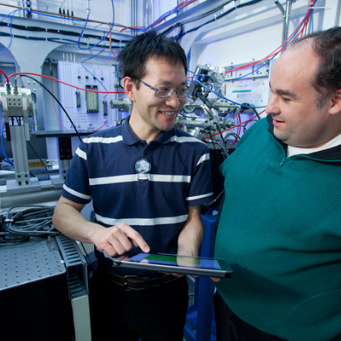Recent Posts
Categories
- Advanced Solutions (12)
- Archeology (7)
- Event Management Solutions (3)
- Events (18)
- Grocery E-commerce (18)
- Innovation (19)
- IT Services (14)
- Land Stewardship (10)
- Locker Solutions (19)
- Natural Resources (7)
- NOC Operations (12)
- Operations (10)
- Science Projects (10)
- Security (8)
- Smart Retail (20)
- Supply Chain (12)
ScienceStudio - Leasons Learned
- Oct. 1, 2012
Our Goal
Back in 2008 when this project started our goal was to build a web-enabled platform that would permit integrated management of Scientific Experiments in material sciences. Something that had not realy been done before. This was a period of time when the fundamental technology of AJAX, SOA, and Web 2.0 were just emerging and starting to beocme viable.
What was novel with the solution we demonstrated was that we also integrated high-performance computing to analyse the resulting data in real-time. Our partners at SharcNet would later take this initial ScienceStudio work and run a series of follow on projects called ANISE to replace the HPC components of ScienceStudio with stream computing.
Overview of It's Use
A good friend Mark Fergason wrote a nice article about our software...
Use of advanced internet technology to bring scientists and leading-edge research infrastructure together half a world apart has been demonstrated between the national synchrotron facilities of Canada and Brazil.
The demonstration in Brazil, observed by Canadian Governor General David Johnston and Dr. Antônio José Roque da Silva, Director of the Brazilian Synchrotron Light Laboratory (LNLS), made use of remote control software developed at the Canadian Light Source (CLS) synchrotron in Saskatoon to access a CLS beamline and collect data from a computer at a research station in the LNLS.
The experiment was initiated from Brazil by Peter MacKinnon, president of the University of Saskatchewan which is home to the CLS. The demonstration involved accessing the VESPERS beamline at the CLS from a computer at the LNLS and taking a series of scans of a tissue sample of Crohn’s Disease, including starting the experimental scans and receiving the resulting data.
“This is an amazing example of the new opportunities for research and collaboration available to scientists and graduate students both in Canada and Brazil thanks to this innovative technology developed at the CLS,” said MacKinnon. “It provides a powerful way for researchers at Canadian universities such as the University of Saskatchewan to exchange ideas and information in real time with colleagues around the world, thereby maximizing public investment in science facilities like the CLS.”
Another demonstration had Canadian and Argentinian researchers performing an experiment at the LNLS using LabWeb, the Brazilian remote access project that uses the new CLS-developed technology. In the same way, scientists located in their lab or office at a university in Brazil, for example, can access the CLS to run experiments directly or collaborate with Canadian researchers and students.
“This project opens a new frontier in scientific research since scientists can perform experiments from anywhere in the world, not only at the place where the laboratory is located,” points out Roque. “This is indeed the concrete realization of the concept of cooperation. From now on, researchers from Canada, Brazil and other countries will be able to exchange their expertise and knowledge working together in real time. This is a big step to improve the collaborative science.”
The CLS software innovation, funded by Canada’s CANARIE Network Enabled Program, has led to a suite of web-based applications called ScienceStudio that involves the University of Western Ontario, Concordia University, and IBM Canada.
“ScienceStudio is the result of the kind of innovation that can happen when partners from major science facilities, universities and industries work together,” notes CLS Executive Director Josef Hormes. “The Canadian Light Source and the Brazilian Synchrotron Light Laboratory are collaborating on a number of exciting projects that will benefit both of our country’s scientific communities.”
Using ScienceStudio, research groups can securely access and run experiments at ‘big science’ research facilities such as the CLS, collect data, collaborate on data analysis and interpretation of results, and schedule additional experiments. Currently, ScienceStudio is in use on a beamline at the CLS, the Nanofabrication Facility at the University of Western Ontario, and the Advanced Light Source in Berkeley, California, as well as at the LNLS and Cenpes/Petrobras, an associated research centre in Brazil.
ScienceStudio and LabWeb are examples of joint projects undertaken by the two synchrotrons as the result of a memorandum of understanding signed in 2008. Another example is the collaborative development of the Brockhouse X-ray Diffraction and Scattering Sector beamlines at the CLS.
Learn more, see some of the paper we have written on Science Studio
REMOTE ACCESS TO THE VESPERS BEAMLINE USING SCIENCE STUDIO Saskatoon
SCIENCE STUDIO: A PROJECT STATUS UPDATE - Kobe, Japan
REMOTE ACCESS TO THE CANADIAN LIGHT SOURCE - Ljubljana, Slovenia

